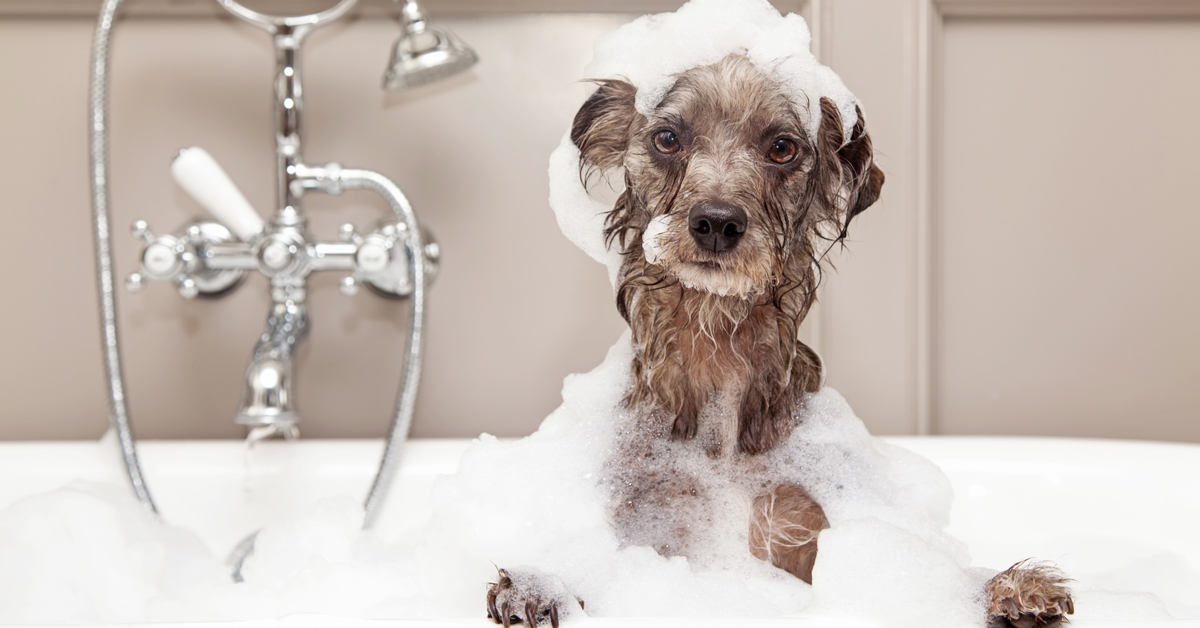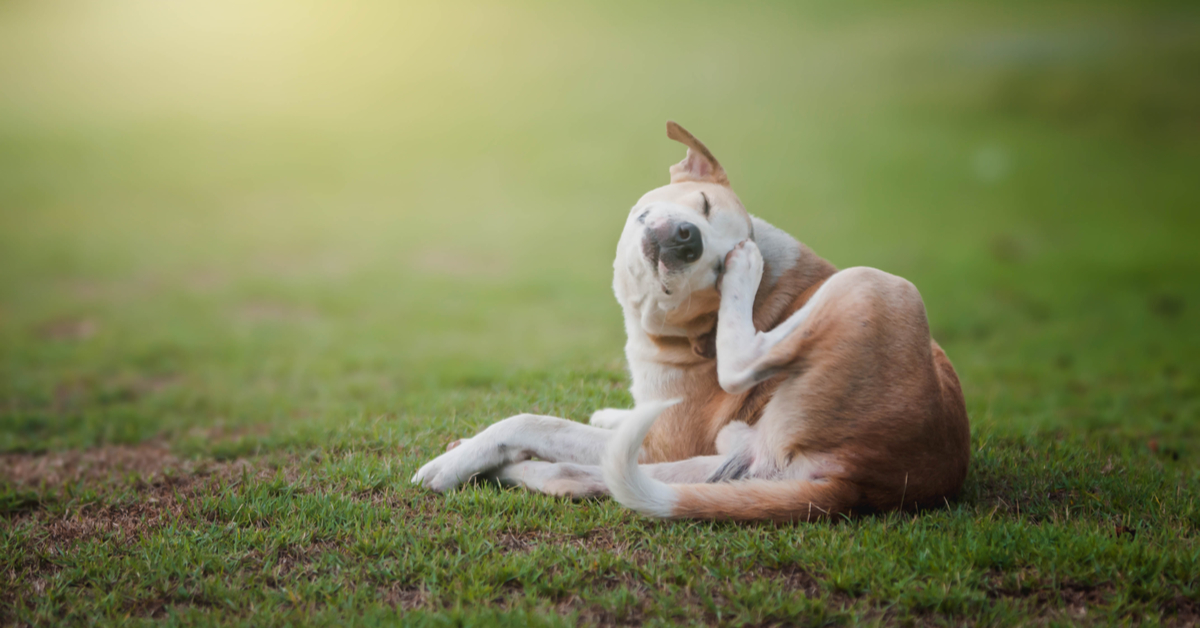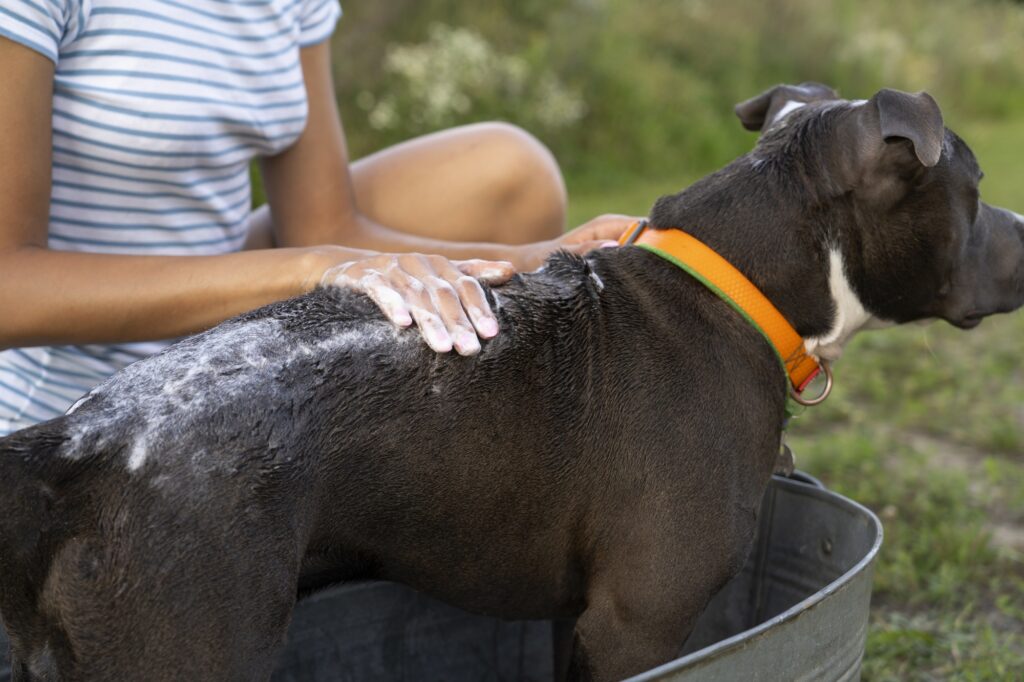Like a lot of bully breeds, my American bully rescue Jack has sensitive skin. For some reason, he gets more flakes on his rear than anywhere else on his body. As a result, his skin condition requires a special doggie anti-dandruff shampoo I jokingly call “Butt & Shoulders.”
His dog shampoo is formulated specifically for a skin condition called seborrhea (more on that later), so human shampoo isn’t exactly going to meet his needs. For other dogs with mildly dry skin, however, pet parents may wonder: can you use Head and Shoulders on a dog?
Keep in mind that you’ll need to consult a veterinarian in order to find the root cause of your dog’s skin condition before knowing how to treat it and what products to use.
Let’s take a look at some common skin problems in dogs and if Head & Shoulders shampoo — or any human shampoo, for that matter — is safe to use on pets with itchy skin.
Is a shampoo like Head & Shoulders safe for dogs?

So, can you use Head and Shoulders on a dog? In short: nope. You should not use human shampoo like Head and Shoulders on a dog.
“It is not advisable to use human shampoo on our pets, especially not medicated shampoos or those targeted at reducing dandruff,” veterinary surgeon Dr. Linda Simon told Outward Hound.
“Ingredients within these products can cause skin irritation as they are not designed for dogs. They can alter the skin pH and make it more likely for dogs to develop dry and itchy skin. More worryingly, they can even lead to the development of skin infections.”
Not all veterinarians 100% agree, however.
Chyrle Bonk, an associate veterinarian at Clearwater Valley Veterinary Clinic in Idaho, told us that while many human products are not recommended to be used on dogs, some human dandruff shampoos are safe to use on dogs from time to time.
“But that doesn’t mean it should be used on a dog regularly. Rather it is safe to use only when needed or as recommended by a veterinarian,” explained Bonk.
To play it safe, the best shampoo for your dog is likely going to be a shampoo made specifically for dogs. If you must go the human shampoo route, be sure to avoid ones with added fragrances, dyes, or harmful ingredients to dogs like tea tree oil.
Zinc poisoning risk
Since dog skin has different ph levels than human skin, using a human shampoo designed specifically for a human’s ph balance could actually make your dog’s skin condition worse.
According to PetMD: “…the dog’s acid mantle will be disrupted, creating an environment where bacteria, parasites, and viruses can run rampant.”
I do not recommend using this product or other human shampoo products for dogs on a long-term basis as they are not formulated for their specific skin and coat needs. — Dr. Michelle Burch, veterinarian
Even worse, if it gets into your dog’s eyes or mouth, they could get zinc poisoning.
Signs of zinc poisoning include:
- vomiting
- lethargy
- diarrhea
- pale or yellow gums
- orange-colored poop
- jaundice
If you suspect your dog ingested something with zinc like human shampoo, body cream, sunscreen, or change/coins, call the Pet Poison Helpline at 800-213-6680 right away.
Common dry skin problems in dogs

It’s not uncommon for dogs to have dermatological issues. According to the University of Illinois College of Veterinary Medicine, 10-15% of the dog population has atopic dermatitis, an inflammatory skin condition associated with allergies.
Other common skin problems in dogs include:
- pruritus
- alopecia
- nonhealing wounds
- erosions and ulcerations
- scaling and crusting
- yeast infection
- nodules or tumors
- odor
- otitis
- bacterial, parasitic, fungal, or viral infection (i.e., seborrhea)
Jack gets seborrheic dermatitis seasonally on his paws. Seborrheic dermatitis is kind of like dandruff 2.0 — VCA Hospitals DVMs Tammy Hunter and Ernest Ward explain seborrhea as “a skin disorder in which the sebaceous glands of the skin produce an excessive amount of sebum causing scaly, flaky, itchy, and red skin.”
It typically results in a combination of oily, flaky skin and distinctive odor.
While there is no definitive treatment, it can be managed with an antibacterial, antifungal medicated shampoo. These types of shampoos often require you to lather in lukewarm water, then leave the product on the skin for 10-15 minutes before rinsing.*
In my dog’s case, regular shampoo, which doesn’t contain the active ingredients required for his skin issues, can’t help the underlying cause of his flaking.
How to treat dog dandruff
If you notice some flakes in your dog’s coat there are a few preventative measures you can take in order to minimize the problem. For example, pet owners can put a pump of fish oil in their dog’s kibble.
Fish oil is a multi-purpose supplement to your dog’s diet. It’s an excellent source of omega-3 fatty acids that support both skin and joint health.
Coconut oil is sometimes used topically to help with itchy skin, fleas, and hot spots. It’s often an ingredient in dandruff shampoos along with coal tar.
Then again, your dog’s skin problems might stem from an allergic reaction to something they eat. Talk to your veterinarian and try an elimination diet to narrow down the culprit. You might need to change the dog food he eats entirely.
It’s also important to brush your dog’s fur regularly. Regular brushing helps to distribute your dog’s natural oils throughout their fur in order to prevent dryness.
*Dog-bathing tips

Stick with shampoos and conditioners that are specifically formulated for dogs. If your dog goes to a groomer, it’s a good idea to BYO-dog shampoo if you use a kind that was prescribed or recommended by your veterinarian.
If you are a dog owner who uses or needs to use the kind of shampoo for dogs that requires it to stay on for several minutes before rinsing, you might be wondering how to keep your pooch calm until rinse time. Well, have I got a hack for you!
Prepare a dog puzzle filled with delicious treats (or peanut butter, which lasts longer) and give it to your dog in the tub to keep him occupied until the timer goes off. (I use the Hide n Slide dog game.)
If he needs to soak his paws in water for a certain amount of time, give your dog a toy that floats in the water like a Planet Dog ball.
Once I started incorporating peanut butter-covered dog toys into bath time, my dog walks into the bathroom willingly when the water’s going. My days of catching, then carrying a 49-lb land seal into the bathroom are in the past.


